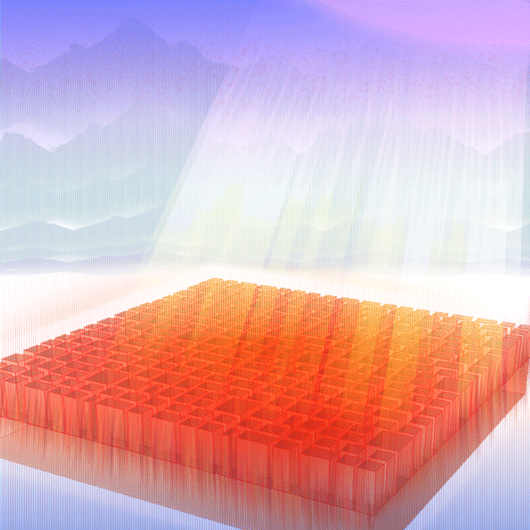An organised mess

A quasi-random structure to maximise performance of a thin film silicon solar cell.
Credit: Dr Li Juntao.
Researchers at the University of St Andrews have developed a new method to increase the efficiency of solar cells… by harnessing chaos.
The new approach achieves highly efficient broad-band light trapping in thin films, with more light captured in the film in order to maximise absorption and electricity generation. The new design could have applications in LED and lasers as well as solar cells.
The research, which is reported in Nature Communications today (Thursday 24 October 2013), was an international collaboration involving scientists from China and Belgium.
The new method builds on research into a class of materials known as quasi-crystals, which offer advantages in terms of the spectrum of light they are able to capture. However, the problem with these structures is that their properties are difficult to tailor towards specific applications.
To solve this problem, the researchers created a new structure called a quasi-random structure, which combines the rich spatial frequencies associated with quasi-crystals with a high level of control.
The idea of the quasi-random structure was developed at St Andrews by postgraduate researcher Emiliano Martins, alongside Thomas F Krauss, who is now at the University of York.
Emiliano, of the School of Physics and Astronomy at St Andrews, said, “The control of propagating light is a crucial aspect in photonics. Disordered and quasi-periodic media provide many advantages over ordered structures to control and manipulate light propagation. We have demonstrated that by a careful design of their Fourier spectra, quasi-random nanostructures can achieve such control very efficiently.”
Professor Krauss added, “Applying our nanophotonics design ideas to such an important area as solar cells is essential for improving the competitiveness of renewable energy generation.”
Calculations for the research into quasi-random cells were conducted by collaborators in China.
Corresponding author Dr Juntao Li, from the State Key Laboratory of Optoelectronic Materials and Technology, Sun Yat-sen University, China, said, “Other than solar cells, our design can also be used in many light trapping areas, like LED and DFB lasers.”
The research was supported by the Scottish Universities Physics Alliance (SUPA), the National Key Basic Research Special Foundation, the National Natural Science Foundation of China and Guangdong Natural Science Foundation.
The article “Deterministic quasi-random nanostructures for photon control” will be published in Nature Communications at www.nature.com/naturecommunications. DOI: 10.1038/ncomms3665
ENDS
Notes to Editors
Emilian Martins (St Andrews) is available for interview on tel: 01334 467333 or email [email protected].
Thomas Krauss can be contacted through Caron Lett at the University of York on 01904 322029.
Issued by the Press Offices of the University of St Andrews and the University of York
St Andrews: Gayle Cook, 01334 467227, email [email protected]
York: Caron Lett, 01904 322029, email [email protected]
Category Research